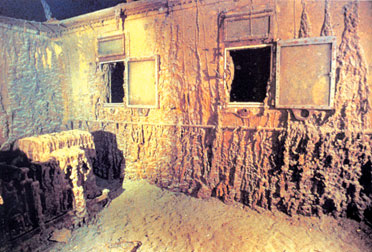Titanic wreck under new threat
 |
|
Since making of the popular movie,
this underwater image of the wreck has become a romantic
image world-wide. |
Titanic has become a worldwide obsession since James Cameron made his
award winning movie 'Titanic' in 1997. Going down in history as the
biggest maritime tragedy, since the sinking on 14th April 1912, its
wreck also has aroused curiosities all over the world. Although hundreds
of attempts were made to find its final resting place, no attempts were
successful until 1 September 1985, when a joint American-French
expedition, led by Jean- Louis Michel and Dr. Robert Ballard, located
the wreck using the side-scan sonar from the research vessels Knorr and
Le Suroit.
Even today, the wreck is surrounded by a large debris field with
pieces of the ship, furniture, dinnerware and personal items scattered
over one square mile.
About 6,000 items were recovered from it and put on display at the
National Maritime Museum in England.
Softer materials, like wood, carpet and human remains were devoured
by undersea organisms. Underwater microbes have been eating away at
Titanic's steel since the ship sank, the National Oceanic and
Atmospheric Administration estimates that the hull and structure of the
ship may collapse to the ocean floor within the next 50 years.
Adding further in to the interesting facts and mysteries of Titanic,
researchers say that a newly discovered species of rust-eating bacteria
has been found on its wreck.
According to them, the micro-organisms, which have never been seen
before, are helping decompose the famous ship at the bottom of the
Atlantic Ocean.
They have isolated the micro-organisms from a 'rusticle' collected
from the ship, which was lying 3.8 km below the ocean surface and have
named their find Halomonas titanicae. The researchers say that the
bacterium could pose a new microbial threat to the exterior of ships and
underwater metal structures such as oil rigs.
 |
|
A picture inside a room
of decomposing Titanic. |
The find is described in 'International Journal of Systematic and
Evolutionary Microbiology'. Samples of rusticles from Titanic were
gathered in 1991 by the Mir 2 robotic submersible. Researchers from
Dalhousie University and the Ontario Science Centre in Canada and the
University of Seville in Spain isolated the H. titanicae bacteria from
those samples.
While these appear to be solid structures, rusticles are highly
porous and support a complex variety of bacteria. The findings also
suggest that H. titanicae may be working alongside other organisms to
speed up the corrosion of the metal. As the researchers believe H.
titanicae plays a part in the recycling of iron structures at certain
depths, they think that that this could be useful in the disposal of old
naval and merchant ships and oil rigs that have been cleaned of toxins
and oil-based products and then sunk in the deep ocean.
The findings also have opened up further areas of research that could
be applied in many other areas.
The 'unsinkable Titanic' was made up of 50,000 tons of iron but has
now been progressively deteriorating for the past 98 years on the cold
dark seabed.
- Chamari Senanayake
|

